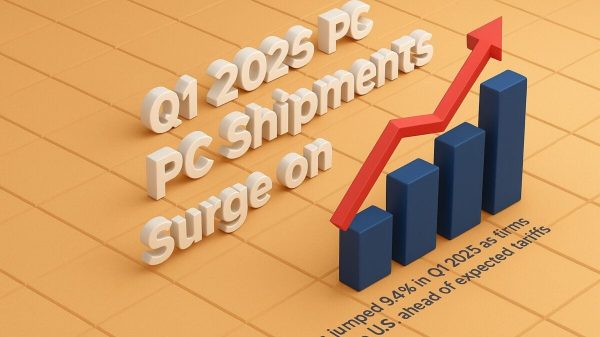In the latest earnings call, PulteGroup, Inc. (NYSE: NYSE:PHM) announced a significant year-over-year increase in earnings per share (EPS) and home closings for the third quarter of 2024. The company’s EPS rose by 16% to $3.35, driven by a 12% increase in home closings. Despite challenges such as recent hurricanes and changing market conditions, PulteGroup has returned $1 billion to shareholders and expects to meet its full-year home closing target.
Key Takeaways
PulteGroup’s EPS increased by 16% year-over-year to $3.35 in Q3.
Home closings rose 12% to 7,924 homes in the same period.
The company returned $1 billion to shareholders through repurchases and dividends.
Average sales price remained stable at $548,000, with a rise expected in Q4.
The backlog at the end of Q3 stood at 12,089 homes, valued at $7.7 billion.
Net new orders peaked in September due to declining interest rates.
Gross margin was reported at 28.8%, with SG&A expenses at $407 million.
The financial services segment saw a 90% increase in pre-tax income to $55 million.
Net income for Q3 reached $698 million.
Company Outlook
PulteGroup anticipates closing between 7,900 and 8,300 homes in Q4.
Full-year closing target is approximately 31,000 homes.
Q4 gross margin projected at 27.5% to 27.8%.
Full-year SG&A forecast is 9.2% to 9.5% of home sale revenues.
Land acquisition investment reached $1.4 billion in Q3, with a full-year spend expected between $5 billion and $5.2 billion.
The company plans to operate 950 communities in Q4.
Bearish Highlights
Higher incentives necessary to maintain sales have influenced gross margins.
Recent rate increases have impacted buyer confidence.
Hurricanes caused operational delays and could affect Q4 deliveries.
Affordability challenges noted in the entry-level segment.
Bullish Highlights
Positive trends in orders, especially in September.
Strong margins in Florida, expected to remain robust due to seasonal demand.
Buyer confidence at a 12-month high, with increased website and foot traffic.
Active adult communities expected to contribute to revenue in 2026.
Misses
SG&A expenses increased to $407 million from $353 million the previous year.
Hurricanes resulted in a loss of 6-8 days in job site operations.
Q&A Highlights
The company is optimistic about Florida’s market dynamics and is not inclined to lower prices significantly despite market pressures.
Texas is competitive, but some price normalization is occurring.
PulteGroup is progressing toward increasing off-balance sheet land options to 70%, currently at 56%.
In conclusion, PulteGroup, Inc. remains confident in its strategic growth and capital management, with plans to continue investing in new community development and maintaining a balanced product mix. The company is also focused on managing costs effectively and navigating market conditions while returning significant value to its shareholders. Further details on the company’s outlook for 2025 will be provided in the next quarter’s earnings call.
InvestingPro Insights
PulteGroup’s strong performance in Q3 2024 is reflected in its robust financial metrics and market position. According to InvestingPro data, the company boasts a market capitalization of $28.19 billion, underscoring its significant presence in the homebuilding sector. The company’s P/E ratio of 10.29 suggests that it may be undervalued relative to its earnings, which aligns with the reported 16% increase in EPS.
An InvestingPro Tip highlights that PulteGroup has raised its dividend for 6 consecutive years, demonstrating a commitment to shareholder returns that complements the $1 billion returned to shareholders mentioned in the earnings call. This is further supported by the company’s dividend growth of 25% in the last twelve months, as reported by InvestingPro.
Another relevant InvestingPro Tip indicates that PulteGroup operates with a moderate level of debt. This prudent financial management is crucial in the current economic environment, especially as the company continues to invest in land acquisition and community development.
The company’s strong performance is also reflected in its impressive 108.55% price total return over the past year, as reported by InvestingPro. This aligns with the positive trends in orders and buyer confidence mentioned in the earnings call.
For investors seeking a more comprehensive analysis, InvestingPro offers 12 additional tips for PulteGroup, providing a deeper understanding of the company’s financial health and market position.
Full transcript – Pulte Group (PHM) Q3 2024:
Operator: Good morning. My name is Audra, and I will be your conference operator today. At this time, I would like to welcome everyone to the PulteGroup, Inc. Third Quarter 2024 Earnings Conference Call. Today’s conference is being recorded. All lines have been placed on mute to prevent any background noise. After the speakers’ remarks, there will be a question-and-answer session. [Operator Instructions] At this time, I would like to turn the conference over to Jim Zeumer. Please go ahead.
James Zeumer: Thank you, Audra, and good morning. I want to welcome all participants to today’s earnings call to review PulteGroup’s operating and financial performance in the company’s Q3 ended September 30, 2024. Here to review PulteGroup’s Q3 results are Ryan Marshall, President and CEO; Bob O’Shaughnessy, Executive Vice President and CFO; and Jim Ossowski, Senior Vice President, Finance. A copy of our earnings release and this morning’s presentation slides have been posted to our corporate website at pultegroup.com. We will post an audio replay of this call later today. I want to alert everyone that today’s presentation includes forward-looking statements about the company’s expected future performance. Actual results could differ materially from those suggested by our comments made today. The most significant risk factors that could affect future results are summarized as part of today’s earnings release and within the accompanying presentation slides. These risk factors and other key information are detailed in our SEC filings, including our annual and quarterly reports. Now, let me turn the call over to Ryan Marshall. Ryan?
Ryan Marshall: Thanks, Jim. I appreciate everyone joining our call this morning as we discuss another quarter of strong operating and financial results for PulteGroup. As detailed in this morning’s press release, driven primarily by a 12% increase in closings, we reported a 16% year-over-year increase in third quarter earnings to $3.35 per share. Inclusive of our strong Q3 financial performance, for the first three quarters of 2024 PulteGroup has realized double digit increases in closings, home sale revenues, and pretax income along with a 22% increase in reported earnings to $10.28 per share. In addition to delivering significant growth in revenues and earnings for the trailing 12 month period, PulteGroup realized a return on equity of 27%, while continuing to drive strong cash flow and lowering our debt to capital ratio to 12%. Our strong financial performance also allowed us to continue returning funds to shareholders. Through the first nine months of 2024, we returned $1 billion to shareholders through share repurchases and dividends. This is an increase of $200 million or 25% from last year in terms of funds allocated back to our investors. I think these numbers are all the more impressive given the fluctuating backdrop that we’ve all been working through. Over the course of the year, we’ve seen the 30-year mortgage rates climb from 6.75% in January, 7.5% in April, only to fall back to 6% in September. And then, of course, a recent climb in interest rates back to 6.75% has the 30-year mortgage rate back to where we started 2024. We track consumer sentiment among visitors to our website and our communities, and as you might expect, buyer confidence ebbs and flows with meaningful changes, or even just volatility and interest rates. This again proved to be the case as buyers reacted to the movement in rates during the third quarter. With mortgage rates hovering around 6.5% to begin the third quarter, buyers were generally less inclined to sign a purchase agreement. As interest rates declined through August and September, however, we experienced a noticeable pickup in overall activity. In fact, of the three months in the quarter, we generated the highest net new orders and absorption paces in the month of September. Driven by September’s strong performance, the Q3 absorption pace of 2.4 orders per community per month was certainly above the typical pre-COVID numbers for the third quarter. The recent — October has shown the highest web traffic, foot traffic and lead volume of the year. However, the recent rise in interest rates has demonstrated a more typical seasonal selling pattern and incentives have remained elevated as a consequence. Between rate volatility, the impact of hurricanes, and the upcoming presidential election, I think the upcoming spring selling season will offer the best assessment of fundamental housing demand. I think buyer reaction to the movement rates, both down and now up, again, affirms that affordability remains a tough hurdle to get over for many potential home buyers. The most recent S&P Case-Shiller Index shows home prices continue to hit all-time new highs, although the rate of appreciation has slowed, which in combination with expected lower mortgage rates could offer some relief to consumers going forward. As has been discussed extensively over the past few years, one of the pressure points that continue to push home prices higher is the fact that after years of underbuilding, this country has a housing deficit estimated at several million homes. The Mortgage Bankers Association issued a useful graphic a few weeks ago that is shown on Slide 15 in today’s webcast slides. The graph shows housing stock added by decades since the 1940s. Looking at the graph, you can clearly see the significant drop in production during the past 15 years. To make this point even clearer, we modified the MBA graph by overlaying the growth in U.S. population over the decades. What you see is that just since the 1960s, our country’s population has almost doubled to just shy of 350 million people, while housing production has been flat to down over the decades. Given the high cost of homeownership, rate buy-downs remain a powerful incentive in helping consumers bridge the affordability gap. In the third quarter, approximately 30% of our home buyers accessed our national rate program. To take advantage of our national rate incentive, home buyers will typically need to close within 30 to 60 days of signing the contract. So it’s important that we continue to have an inventory of homes in production. At the end of the third quarter, 43% of the homes in production were specs, so we are well positioned to meet demand as we close out 2024. Along with benefiting from having inventory available, we are also continuing to make progress in lowering our cycle times. For homes delivered in the third quarter, our average cycle time was 114 days, down from 123 days in this year’s second quarter. Cutting two weeks out of our production timeline is an important accomplishment, and it keeps us on track to reach our goal of 110 days by year end and be at 100 days in the first part of 2025. In truth, most of our divisions are already operating at or close to our 100-day ideal target. Our reported average is higher due to a handful of divisions, primarily those with large multi-family business, where cycle times remain elevated. In summary, operationally and financially, we accomplished a lot in the third quarter and are well positioned to have 2024 be a record year for PulteGroup. Now let me turn the call over to Bob for a review of our third quarter results.
Robert O’Shaughnessy: Thanks, Ryan. And good morning. Driven by strong closing volumes, our third quarter home sale revenues increased 12% over last year to $4.3 billion. Our higher revenues in the period reflect a 12% increase in closings to 7,924 homes, while our average sales price in the quarter of $548,000 is effectively unchanged from the prior year and the second quarter of this year. Average sales prices by buyer group were also consistent with the prior year. The mix of our closings in the third quarter was 40% first time, 39% move up, and 21% active adult. In the third quarter of last year, the mix of closings was 38% first time, 37% move up, and 25% active adult. A slight decline in the percentage of closings from active adult buyers primarily reflects the timing of active adult community closeouts in 2023 and 2024 that we noted in our sign-up commentary during our second quarter earnings call. We expect a normalization of contribution from our active adult consumers when replacement active adult communities begin opening in 2025. Looking at our orders, net new orders in the third quarter totaled 7,031 homes, which is consistent with the 7,065 net new orders recorded in the third quarter of last year. It’s worth noting that our average monthly absorption pace of 2.4 homes in the current quarter remains higher than our historic third quarter pre-COVID average, which was closer to 2.2 homes per month. Within the quarter, we did see a positive impact on monthly orders as interest rates declined from July through September. Compared with the prior year, Q3 orders decreased 3% for first time buyers, increased 6% for move up buyers, and decreased 5% for active adult buyers. Consistent with our guide, we operated out of an average of 957 communities during the quarter, which is an increase of just under 4% compared with the third quarter of last year. Based on activity during the quarter, quarter end backlog was 12,089 homes with a value of $7.7 billion, which compares with the backlog of 13,547 homes with a value of $8.1 billion at the end of the third quarter last year. During the quarter, we started approximately 7,800 homes and ended the quarter with a total of 17,096 homes under construction. These numbers are consistent with Q3 of last year. At the end of the quarter, we had approximately 7,400 spec homes in production, of which 1,357 homes were complete. This represents about 1.4 finished specs per community, which is consistent with the second quarter of this year. On a unit basis, 58% of our third quarter sales were spec sales, highlighting the importance of having inventory available to meet buyer demand. Buyer interest in spec production has been driven in part by our successful use of mortgage incentives, which are most effective when the consumer expects to close quickly. As always, we will continue to closely monitor consumer preferences for any changes if mortgage rates continue to decline. Based on the units we have under construction and their current stage of production, we currently expect to close between 7,900 and 8,300 homes in the fourth quarter. I would highlight that this keeps us on track to meet or slightly exceed our full year closing target of 31,000 homes. Given the affordability challenges facing today’s homebuying consumers and evolving market dynamics in key cities in which we operate, our pricing strategy seeks to ensure we maintain a compelling offering to all consumers. With that said, our average sales price in the third quarter was $548,000, which is consistent with our guide for average pricing to be in the range of $540,000 to $550,000. Looking at the fourth quarter, we currently expect our average sales price to be in a higher range of $555,000 to $565,000. As we have discussed on prior calls, this is largely due to a higher percentage of our closings coming from our western markets where selling prices are above company average. Our third quarter gross margin came in at a strong 28.8%. As we highlighted during our most recent earnings call, our margins in this quarter reflect an increasing percentage of our closings coming from our western markets, which relative to other parts of our business, have slightly lower margins. Our third quarter margins were also impacted by higher incentive costs incurred during the period. Incentives in the third quarter were 7%, which is a sequential increase of 70 basis points from the second quarter of this year. Given competitive market dynamics, higher incentives were needed to help ensure we continue to sell homes and turn our assets. As Ryan talked about, higher demand improved as interest rates declined in the third quarter, but overall market dynamics remain competitive. As such, we expect incentives to remain elevated for at least the remainder of the year. Given the anticipated geographic and product mix of fourth quarter closings and the expected need to maintain higher incentives, we currently expect gross margin in the fourth quarter to be in the range of 27.5% to 27.8%. Based on our fourth quarter guide, our full year gross margin would amount to approximately 29%. Continuing down the income statement, our reported SG&A expense in the third quarter was $407 million, or 9.4% of home sale revenues. This compares with prior year’s SG&A expense of $353 million, or 9.1% of home sale revenues. Our third quarter SG&A expense was in line with previous guidance and keeps us on track for SG&A expense of 9.2% to 9.5% of home sale revenues for the full year. I would note that our full year guide excludes the impact of the insurance adjustments recorded in the first and second quarters of this year. Our financial services operations reported another quarter of strong operating and financial results, as third quarter pre-tax income increased 90% over last year to $55 million. For the quarter, our financial services operations benefited from increased volume driven by the higher closing volumes in our home building business in combination with improved capture rates. In addition, we experienced increased profitability, particularly in our mortgage operations, due to improving market conditions driving higher market performance. In total for the quarter, we reported pre-tax income of $906 million, which represents an increase of 7% over the third quarter of last year. Our tax expense for the quarter was $208 million, or an effective tax rate of 23%. Our effective tax rate for the quarter includes a $14 million benefit associated with the purchase of renewable energy tax credits completed in the quarter. In the fourth quarter, we expect our tax rate to be in the range of 24% to 24.5%, excluding the impact of any potential incremental energy tax credit purchases. Looking at the bottom line, our reported net income was $698 billion, $3.35 per share, representing increases of 9% and 16%, respectively over the third quarter of last year. Earnings per share in the third quarter was calculated based on approximately 208 million diluted shares outstanding, which is down 5% from the prior year as the company continued to systematically executed share repurchase program. Consistent with our stated strategies, we continue to allocate incremental capital to the future growth of our home building platform. In the third quarter, we invested $1.4 billion in land acquisition and development, of which 56% was for the development of existing land assets. On a year to date basis, we have invested $3.7 billion in land acquisition and development, and now expect our full year spend to be in the range of $5 billion to $5.2 billion as our land teams continue to do an exceptional job identifying and structuring land investments that meet our strict underwriting guidelines. Inclusive of our land spend in the quarter, we ended the quarter with approximately 235,000 lots under control, of which 56% were held via option. We continue to make steady progress in increasing the percentage of our land that we control via option as we seek to drive greater balance sheet efficiency in support of higher returns in the future. Based on our land pipelines and the expected timing of community openings and closings, we currently expect to operate out of an average of 950 communities in the fourth quarter, which would represent an increase of 3% over the fourth quarter of last year. In addition to investing in the ongoing growth of our business, we continue to consistently return capital to shareholders. In the third quarter, we repurchased 2.5 billion common shares at a cost of $320 million, for an average price of $126.05 per share. Through the first nine months of the year, we have repurchased 7.6 million shares, or approximately 4% of our shares outstanding at the beginning of the year at a cost of $880 million or $115.74 per share Following these repurchases, we ended the period with just over $1 billion remaining on our existing repurchase authorization. And finally, we ended the third quarter with a gross debt to capital ratio of 12.3%. Adjusting for the $1.5 billion cash on our balance sheet, our net debt to capital ratio was 1.4%. Now, let me turn the call back to Ryan for some final comments.
Ryan Marshall: Thanks, Bob. I’m very proud of our organization as our local and national teams have done a great job navigating the ups and downs of 2024. Within such an environment, it’s more important than ever that we continue to focus on the critical business strategies and tactics that have been instrumental to our success. First, we are continuing to invest in our business. We expect to invest just over $5 billion in land acquisition and development this year, underwriting to the same return hurdles and guidelines that we’ve had in place for more than a decade. Our disciplined process has allowed us to assemble a robust pipeline of what we believe are well located and high returning projects. In the process of underwriting new deals, we continue our migration toward controlling more land via option. This will be a multi-year effort, but we see the opportunity for increasing our option lot count as a way to enhance returns and help mitigate market risk. We have a long-term goal of getting to 70% option lots, which will be an evolutionary process as we work through our existing communities and add new option lot deals to the overall portfolio. Second, while we continue to invest in new land positions, we have to make sure we are efficiently and intelligently turning our existing land assets. Within our business model, we seek to achieve high returns by balancing the desire to maximize profitability of each home, while making sure we are turning our land assets. We often use the phrase, we can’t be margin proud. The gross margin is an important driver of return on invested capital, and we don’t want to give away lots that we’ve worked hard to secure. At the same time, we must be price competitive and offer a clear and compelling value to potential home buyers. I think our third quarter results show this balancing act as we continue to generate historically high gross margins, but we meaningfully increased incentives in response to the more competitive market conditions in which we are currently operating. And third, we must continue to allocate capital in alignment with our long stated priorities. As just discussed, we continue to invest in the ongoing growth of our business through land acquisition and development. If we achieve our 2024 land investment target of $5 billion, our five year land acquisition and development spend will total more than $20 billion. In a world where not in my backyard, it is alive and well, such investment represents countless hours of hard work by our land teams throughout the country. After investing capital to support the ongoing growth of our business, we continue to systematically return funds to shareholders, with 2024 being the fourth year in a row in which we will have returned over $1 billion back to shareholders through share repurchases and dividends. Over $20 billion invested in land, over $4 billion returned to shareholders and all while building a strong and highly supportive balance sheet with low leverage and high liquidity. I strongly believe this is a balance sheet that can support our growth plans, as well as continue to see us through the ups and downs of buyer demand that inevitably rolled through the housing industry. Let me close by thanking our entire organization for their hard work in delivering PulteGroup’s outstanding operating and financial results. Hurricanes made this effort even tougher over the past few months, but I am incredibly proud, although not at all surprised, of how our team rallied to support fellow employees directly impacted by these storms. Your compassionate efforts are why PulteGroup remains a great place to work. Now I’ll return the call back to Jim.
James Zeumer: Thanks, Ryan. We’re now prepared to open the call for questions. So we can get to as many questions as possible during the remaining time of this call. We ask that you limit yourself to one question and one follow-up. Thank you. And I’ll ask Audra to again explain the process and open the call for questions. Audra?
Operator: Thank you. We will now begin the question-and-answer session. [Operator Instructions] We’ll go first to John Lovallo at UBS.
John Lovallo: Good morning, guys. Thank you for taking my questions. The first one is maybe just help us on the sequential walk in gross margin from 28.8% in the third quarter to the range of 27.5% to 27.8% in the fourth quarter. Does that assume an incremental step up in incentives? And what is sort of the breakout between the headwind from incentives versus mix?
Robert O’Shaughnessy: Hey, John. I think it’s reflective of the current market that we’re operating in. We highlighted in the commentary as it relates to Q3, coming into the quarter, we had given the guide and said that incentives would be flat. Obviously, they were a little bit richer than we had expected. We had a lot of homes to sell in the third quarter. The activity that we have seen has had that higher incentive load. We still have homes to sell in the fourth quarter. So it really is just a function of what we’re seeing on the ground today. Another thing more broadly that impacts this is the slight step down in the active adult as a percentage of the mix. And so, we’re — we highlighted during the second quarter that we saw some closeouts, and so we’ve got some, for lack of better word, gap outs in active adult. So you’ve seen the percentage of our total business in active adult shrink a couple of basis points. That obviously has the highest margin contribution. So it’s the combination of all those factors.
John Lovallo: Understood. Okay. And then, Ryan mentioned, the hurricanes, obviously, there were two pretty devastating storms, Milton really hitting Florida pretty hard, and Helene going up into the Carolinas. What is the impact that you guys perhaps saw in the quarter, and what are you kind of contemplating as we move forward here as a potential impact on whether it’s deliveries, orders, or whatever the case may be?
Ryan Marshall: Yes, John, it’s Ryan. First thoughts and prayers go out to the communities and the individual families who were impacted by the storms. They were certainly both very large and devastating in different ways. I maybe start first by highlighting how well our communities performed. Both our communities that are in active construction as well as homes that we’ve recently closed. The new construction standards and the quality that we built to, the way the drainage systems are designed, I think are a real testament to just how effective some of those standards are. So we had very little damage in our active communities, which is a good news. The biggest impact is really two things, John. One, loss of time. So the three to four days to shut job sites down in advance of the storm, and then the three to four days kind of following the storms with cleanup. Those are days that are just hard to get back. Power is the second issue. So especially with Milton, the power outages were really widespread in Florida, especially in the Tampa and Southwest Florida areas. So power crews are focused on bringing the power grids back online. They’re not as focused on setting new electrical meters for homes that will deliver in Q4. So we’re still kind of working to quantify what those exact numbers are. We’re confident in the guide that we’ve — that Bob has provided to you. And we’ll know more, I think, in the coming weeks as the power companies recover. The other maybe kind of third tier item would be some of the municipalities will be a little slower in responding to inspections, as they’re dealing with kind of cleanup areas in the hard hit communities.
John Lovallo: Great. Thanks very much guys.
Operator: We’ll move next to Alan Ratner at Zelman & Associates.
Alan Ratner: Hey, guys. Good morning. Thanks for taking the questions. Hey, Ryan. Just following up on the margin guide, you mentioned the mix of the business, the active adult, etc. And you kind of touched on the storms. But I guess this is kind of like a two part question specific to Florida. Your margins in Florida are well above company average. So I’m curious if that’s impacting specifically the 4Q numbers, specifically for the guidance. But kind of more importantly, I guess, if you could just talk a little bit about what you are seeing in Florida outside of the storm impact? There’s a lot of concern about rising resale inventory in the market, challenged affordability. And I’m just curious how you guys are thinking about that market relative to your very strong margins. Do you think there’s an opportunity maybe to take advantage of that with taking share, maybe more incentivizing? Or do you feel like your land position in that market is so strong that you’re, as you mentioned, not looking to give away those lots?
Ryan Marshall: Yes, Alan. We’re actually — we remain very bullish on Florida. We talked about it a little bit in the end of our second quarter. And on a positive note, we had a great third quarter out of Florida. And a lot of the inventory trends, both on resale inventory and new inventory, have improved and they’re down from where things peaked. So I think that’s a positive in a quarter, which is typically one of the slower quarters in Florida is you end the nicer weather summer months up north. As we move into the fourth quarter and we get into what is the traditional [shoulder] (ph) season in Florida, where the snowbirds start coming back into town, I think we’re well positioned to have a pretty good fourth quarter. So we’re in every major city or almost every major city in Florida. We don’t do a lot of business in Miami, but we’re — our brands are really strong there. We’ve got great communities. So I think Florida will continue to be a positive for us.
Robert O’Shaughnessy: Yes, Alan, it’s interesting. You heard Ryan say how well our markets held up there. So we don’t see a mix shift in the fourth quarter pending, of course, the municipality’s ability to actually deliver permits, which you think that they will and we think we’ll be able to work through. We had highlighted more of the geography and the margin is really that western markets have on a relative basis slightly lower margins for us and that’s going to be a higher percentage in the fourth quarter than it was in the third. And then it’s the incentives on the spec or entry level probably that have more influence and as we highlighted in the prepared remarks, our expectation is that, the incentive levels are going to stay high.
Alan Ratner: Got it. That’s helpful, Bob. And you kind of touched on — you mentioned entry level higher incentives. I guess more broadly, you guys are one of, if not, the most diversified builders from a price point perspective. Can you just drill in a little bit in terms of what you’re seeing at the various segments in terms of demand right now between entry, move up and active adult? I know you give the numbers on orders, but that doesn’t always tell the whole story, given community count, openings and closings, et cetera.
Ryan Marshall: Yes, Alan, I’ll take that one. I mentioned in my prepared remarks in October, and we’ve talked about it on prior calls, we do a survey with buyers that come to our website just about how confident they are about now being a good time to buy. We’re at a 12-month high in that number, so I think that’s generally a positive sign for the business. Our website traffic, our lead traffic, and our foot traffic into our stores also at 12 month highs. So there’s a lot of real positive activity in the top of the funnel. And September was the best month in the quarter. Drilling down into the individual brands, the entry level buyer continues to be most challenged by affordability. So when rates came down in September, I think we saw a nice pickup in buying power that had a very favorable impact to that particular buyer. So I think that’s a positive. The move up buyer continues to be really strong for us. And with that being 40% of our business, I think we’re really well positioned for that consumer group to continue to perform well in the current environment. And if we’re fortunate enough to see some improved rates in the next couple of months as we go into spring selling season, I think that particular buyer group will perform very well. And then active adult, and we’ve talked about this in years past, this is a buyer group that’s probably most impacted by volatility in the market and uncertainty in the market. And right now, the thing that we’re hearing the most about is the election. And there’s just — there’s a lot of uncertainty around the nonstop barrage that we’re getting with the election in a couple of weeks. So we’re kind of waiting for the next couple of weeks to be over. And we think that buyer will come back into the market shortly thereafter.
Alan Ratner: Appreciate it. Thanks a lot, guys.
Operator: And we’ll go next to Stephen Kim at Evercore ISI.
Stephen Kim: Yes, thanks very much, guys. Appreciate all the information so far. I wanted to focus specifically on timing. I think, you made a couple of comments about what you think may happen next year. I think you indicated that you thought that given the volatility in buyer demand due to rates that maybe we’re really going to have to look to the spring selling season to sort of see how the market is ultimately going to settle out. And I think you’re right on that. I think that the spring selling season is going to be a big focus probably for investors as well. And so, I’m just trying to get a sense for how you might see timing of certain things you’ve talked about evolve here over the next — what it means for timing, I guess I should say. So first of all, you talked about the hurricane impact. You think that some of the delays that you felt from that will impact fully 4Q. Do you think that there’s going to be any spillover into 1Q, particularly as it relates to deliveries, the revenues? You talked about the timing of the active adult gap out. I think you indicated that you thought that that would get better in 2025. Can you give us a sense for sort of when in 2025? And when in particular that might affect revenues because, obviously, these homes may take a while to build. Those are the two major ones that I wanted to understand better, what you’re thinking about from a timing perspective?
Ryan Marshall: Yes, Stephen, it’s Ryan. Thanks for the question. We’ve given a guide for Q4 that we’re confident in. So we think we’ve factored in kind of our best estimate of what the hurricane related delays and impacts will be. Things go quicker and better than expected. Potentially we get a few more closings in the fourth quarter, but we’re confident in the guide that we’ve given. Then, as it relates to kind of 2025 and spillover impact from the hurricane, We haven’t given a guide at this point. We’ll do that at the end of next quarter. History is a guide. I think the system will come back online. And other than, again, power related setting of transformers and energizing communities, those are the things that I think we sometimes see some delays around. But we’ll tell you more about that as we get closer. As it relates to kind of active adult, we’ll also give you our community count guide next year. Those communities have been on the pipeline for a long time. They’re actively being developed right now. So we’ve got great visibility to when they’re going to open. And most of those will start to open in the back half of 2025 and then start to show closings in 2026. But we haven’t given a guide for 2025, other than, I would reiterate, we’ve talked about kind of our long-term growth guide of wanting to operate the business in a 5% to 10% growth window.
Stephen Kim: And if we look — just staying on the active adult side a little bit, it sounds like 2024 — most of 2024 had maybe a richer mix of active adult than we’re going to have in 2025. And just — and then it will, sounds like it’ll become a little richer again. When you’re thinking about managing the business over the long term, Ryan, which is more typical of what you think that the product mix, particularly I’m speaking about active adult, is likely to be for your company. Are you managing it with the land that you’re sort of purchasing today? Are you managing it to more like of a mix of 2024 or more of a mix of 2025?
Ryan Marshall: Yes, Stephen, we’re still running the company and managing the land mix. It’s important to be 25% — about 25% of the business. So the current mix in 2024 is actually on the light side. And as these new communities, where we’re in a little bit of a gap out, as those come online in 2025, you’ll actually, and Bob mentioned it in his prepared remarks, you’ll see the mix go back to our kind of typical contribution levels, which is in that roughly 25% overall business.
Stephen Kim: Got you. Certainly as it relates to orders. Okay, I got you. That’s helpful. Thanks very much guys.
Operator: We’ll go next to Anthony Pettinari at Citi.
Anthony Pettinari: Good morning. I was wondering if you could talk about stick and brick costs in the quarter and then assumptions for 4Q. And it seems like lumber may have been kind of a good guy for part of this year on a year-over-year basis, but it’s kind of ticked up recently. Just wondering if you could remind us your lag on lumber prices and any thoughts there?
Robert O’Shaughnessy: Thanks for the question. To be honest, we’ve experienced minimal inflation on our vertical costs this year. We’re running right at $80 a square foot, which is consistent with the last three quarters and actually consistent with third quarter of last year. So when we look at it for the full year, we expect kind of a very low single digit inflation on our vertical costs.
Ryan Marshall: Anthony, as it relates to lumber, it varies by market. Most of our lumber we buy on a 13-week trailing random length average. It effectively helps lock in the margin at the time of contract with the customer so that we’re not experiencing margin volatility during the build process.
Anthony Pettinari: Got it. Got it. Thank you. And then just following up on resale inventories. Ryan, I think you indicated inventories were kind of maybe getting a little bit better or normalizing a bit compared to three months ago in Florida. And I was just wondering if there were other markets, Texas or out West where resale inventories are a little bit elevated or conversely where — markets where inventories feel tight?
Ryan Marshall: Yes, I wouldn’t highlight any other markets in terms of kind of inventory issues. You mentioned Texas. Texas is the market that’s been a little choppier in the last few months. It’s a place where there’s probably more competition. Every major builder is in every market in Texas. So — and there were a few markets there. Austin is one I highlight that had unprecedented price appreciation, that there were really high paying jobs that went there post COVID, with a lot of relocations and there were short inventories. So we saw maybe less than — less than kind of moderated pace around price appreciation. So I think there’s a few markets there that are probably still going through some price normalization, those are markets that I think will continue to fare well. There’s good jobs there, taxes are relatively affordable and there are places where people want to be. So we’re still confident on our Texas markets as well.
Anthony Pettinari: Okay. That’s helpful. I’ll turn it over.
Operator: We’ll take our next question from Michael Rehaut at JP Morgan. And Michael, your line is open. You may have yourself muted.
Michael Rehaut: Yep. Thank you. Thanks, everyone. Good morning. I wanted to circle back a little bit to the cadence of incentives during the quarter. I think you broadly kind of described incentives as having remained elevated throughout the quarter, you expected to remain elevated into the fourth quarter. I was curious on where incentives began 3Q and where it ended. And if there was any decline in incentives in September, as you said, you had particularly strong demand.
Ryan Marshall: Yes, Mike, I think you can see from the guide that we’ve given and we’ve suggested — not suggested, we’ve told you we seen elevated incentives continuing. We didn’t really see those mitigate during the quarter. It’s worth highlighting, the rate that we’re offering is below market already. And so, the movement in the 30-year doesn’t really influence us as much as what do we need to do both competitively and from the affordability construct for the consumer. So, if you see a 25 basis point move in the 30 year, we’re already 100 plus inside that with our incentive programs. And so, what we’re telling you is that the consumer needs some help with the affordability and the incentives in the way we’re getting there.
Robert O’Shaughnessy: Right. I guess what I’m getting at is, typically when you do see an increase in demand, maybe it’s not the initial reaction, but over, let’s say, several months, I believe it is kind of normal to see incentives start to take down at that overall higher level of demand kind of works through. So I’m curious, that’s really what I’m more curious about, maybe if it’s not the first month of a reaction, given that you said it was really more concentrated in September in terms of the improvement in demand. If you know that were to have been more sustained over the following months, if you would normally see that, I think what I would characterize as a typical decline in incentives, at least for the move up buyers perhaps, which aren’t helped as much by that rate buy down. That’s what I’m more curious about, I guess.
Robert O’Shaughnessy: Yes, we’ll have to see, I think is the answer to that. We — rates ticked back up, right? So at the end of the day, we’ll see if the Fed continues down a path to reduce interest rates and Ryan said in his prepared comments, we think that the selling season is going to be a better indicator of overall demand. And to your point, if the rate environment improves and demand is strong, yes, I think we’d have an opportunity to reduce our incentive.
Michael Rehaut: Right. Secondly, just on from a regional perspective, you kind of highlighted the inventory dynamics in Florida and Texas. I’m curious also for those markets, relative to the rest of your markets, if you’ve seen an increase in incentives in those markets, just given all the hype around resale inventory levels, if you’ve seen a significant or unusual increase in incentives in those markets, let’s say, today versus six months ago.
Ryan Marshall: Yes, Texas, Mike, is the market that I would tell you has probably been more competitive just because of the number of competitors that are there. It’s nothing that I would suggest is — I wouldn’t suggest anything, we’ve done is out of line or is on the level of making us uncomfortable, but probably higher incentives in the Texas markets than what we saw earlier in the year. I think Bob just indicated, we’ll see what the fourth quarter kind of provides is possibly we see some reduction in interest rates and that may give us the opportunity to back off of incentives a little bit.
Michael Rehaut: All right, thanks so much.
Operator: We’ll go next to Mike Dahl at RBC Capital Markets.
Michael Dahl: Hey, Thanks for taking my questions. We’re going to stick with margin dynamics. So, Bob, I think last quarter when you guided to kind of sequential step down in margins inn 3Q and 4Q relative to 2Q, you already anticipated the mix dynamic, so is the mix even different and more of a headwind in 4Q than you originally anticipated or is the right way to think about the sequential and 4Q gross margin really — you already — you’ve highlighted the mix. That’s what it is. But the delta versus your prior guide is really the incentive load.
Robert O’Shaughnessy: Yes, on balance, it’s not changing dramatically. We’ve got a little bit more Western market business, again, the strength there on a relative basis, it really relates to the incentives or as we’ve highlighted a couple of times now, it’s a challenging affordability equation and we’re looking to meet it so that we turn our assets.
Michael Dahl: Yes, that makes sense. And then the follow-up is really drilling down on incentives. If you can provide a little more color, you talked about the 7% on total incentive load, and that’s up 70 bps sequentially. But in the commentary, it seems like it’s suggested it’s really that the incremental change may have been predominantly on entry level. Can you help us quantify what the incentives on entry level are or were in 3Q and in your 4Q guide and maybe how that compares quarter-on-quarter.
Robert O’Shaughnessy: Yeah, that’s probably a slice of the [indiscernible] a little too thin. Again, affordability is a challenge for all of our consumers. The entry level feels it first and the most, and so it’s going to be a little bit richer for them, but I wouldn’t want to parse it quite that thinly.
Michael Dahl: Got it. Okay. Thank you.
Operator: We’ll go next to Carl Reichardt at BTIG.
Carl Reichardt: Thanks. Hi, guys. Nice to talk to you. I want to go back to Florida again, sort of bigger picture and longer term. So obviously, there’s been some talk about intermediate term migration patterns changing there, whether that’s the frequency of weather or insurance conditions, high prices. So if you’re thinking about investing capital, say in 2027 or beyond in new deals there, do these dynamics impact your thinking, especially given those markets are competitive too, as you’re talking about Texas? Do you require a higher rate of return to invest there? How do you think about sort of beyond the very — the intermediate term, the short term, in terms of where you place capital regionally, if you think these dynamics in Florida might be changing, or are you sticking with it?
Ryan Marshall: Yes, Carl, thanks for the question. Florida has been very good to our business. We do have a lot of capital invested there today. So for what it’s worth, we’d like to continue to see Florida perform well for the investments that we’ve already made and the capital that’s already been committed. As it relates to future stuff, I think we’ll take inputs as they come from the market. We’re not going to blindly continue to go after things if we’re seeing a change in market conditions. I think that’s one of the disciplines that we have in our underwriting criteria. I still remain really bullish on Florida. In fact, if you look at the parts of Florida where we’re investing, they’re a little more inland. They’re on higher ground. They’re not places that are being impacted by the things that you see on TV. Some of the things that you see on TV are the things that are right on the beach. They’re the coastal areas. There are homes that were built in the 70s and 80s, not up to current code. It’s devastating. It’s terrible. I don’t think anybody would want it to happen. But my sense is, our business is not probably directly impacted by some of the things that you’re seeing on TV. I’d highlight that some of the moves that you’re seeing are kind of within Florida. So they’re intra Florida moves as opposed to out of Florida moves. Florida remains a place that’s got great quality of life. Maybe it’s not as favorable of a deal as it used to be, but still relatively affordable. There’s good jobs there. There’s no state income taxes. So there are some offsets to some of the things like rising insurance rates and the like.
Carl Reichardt: Thanks, Ryan, I appreciate that. And then my second question is on off balance sheet. 56% off balance sheet now or option lots and the 70% is the goal. Is it still your intention to bridge that gap via effective land banking and as opposed to, say, farmer options? And what are you seeing right now in the land banking market in terms of pricing terms? Have the negotiations, the discussions you’ve had with the large bankers kind of gone as you expected or are you seeing challenges there that you didn’t expect? Thanks, guys.
Ryan Marshall: Yeah, Carl, we’re making nice progress on our land options, up to 56% in the quarter. We’ve highlighted it’ll be a journey. We think it’ll probably take somewhere around three — three to three and a half years in total. As we cycle through our land portfolio to accrete up to the 70% level, but we’re clicking off the milestones as intended. So I’m really pleased with how our land teams are performing on that front. We’d expect 50% of our land to be with farmer options or land seller options. The other 20% that we’re looking for to be optioned will come from bankers. Our land banking team’s done a really nice job building out a portfolio of bankers that we’re working with. They’re consistent, they’re behaving in a very predictable way, and it’s working out incredibly well for us. Interest rates, their money is tied to kind of what you see in the interest rate environment more broadly in the market. So we got a little bit of improvement on some stuff that we did in the third quarter. We’ll have to see how things go in the fourth quarter, depending on what happens with rates. But we’re pleased with how the land banking program is working.
Carl Reichardt: Thanks, Ryan. Thanks, everybody.
Operator: We’ll take our next question from Trevor Allinson at Wolfe Research.
Trevor Allinson: Hi. Good morning. Thank you for taking my questions. First, a question on conversion rates. You guys talked about 5% to 10% growth annually. I think that included 2025. Just given where your backlog is trending, I think that would imply a pretty notable improvement in backlog conversion rate next year to grow closing to 5% or more. So any commentary on is that what you’re expecting, improvement in conversion rates? And then if so, maybe talk about the drivers of that, whether that be the improved cycle time that you guys referenced earlier or any additional spec, any other drivers to call out?
Ryan Marshall: Yes, Trevor. Backload conversion rate is something that — that’s a number that can be impacted by two things. One, cycle time, getting better or worse. We indicated in the prepared remarks our cycle times will continue to come down. So we’ll certainly get some benefit from that. And then the other piece is spec inventory by the definition, those homes that are in production that are spec are not in backlog. So, a lot of those will sell and convert in the same quarter and they won’t show up in that metric. So, I don’t want to tell you how to run your models, but given the percentage of spec inventory that we’re starting and selling, given the current interest rate environment, I think probably a better metric is to look at homes in production, total homes in production, as a good indicator of whether or not we have the available homes to deliver in the next year’s closing volume.
Trevor Allinson: Okay, understood. And then I guess the second question then would be kind of following up on that. Finished inventory, 1.4 finished specs per community. That’s a little bit above your longer term target number of one. Can you talk about how you feel about your current completed specs level and how you’re thinking about spec production then moving forward?
Ryan Marshall: Yes, in the current environment we’re selling — almost 40% of our business is coming through first time, which tends to be predominantly spec or mostly spec. And in the current interest rate environment, we actually want higher spec inventory as a percentage of WIP. And when we had historically pre-COVID operated at. So the things that you’ve heard us most recently talk about is being between 35% and 45% of total WIP and at the end of this most recent quarter we’re at 40 — I think 42% of our total inventory is spec. So we feel like we’re right in line there. On the finish side, when we were operating in more of a built to order model, I think one per community was a pretty good number. And we’re not abandoning that. We’re slightly over that at 1.4. But we don’t feel that we have any inventory exposure that’s got us uncomfortable at this point. We’re selling over 50% of the homes that we’re selling right now are selling at some form of spec, so they’re at some form of production moving through the pipeline. So we feel pretty good there as well.
Trevor Allinson: Okay, makes sense. Thank you for taking my question and good luck moving forward.
Operator: Next we’ll go to Sam Reid at Wells Fargo.
Sam Reid: Awesome, thanks so much. Last quarter I want to say you guys mentioned that land costs were likely to trend up about high single digits in 2024. Just looking to confirm kind of how that trended in the third quarter, what’s embedded in the fourth quarter guidance? And then I know you’re not necessarily talking 2025 now, but you do have some visibility here. So just curious as to whether that’s a reasonable assumption in the next year.
Robert O’Shaughnessy: Yes, we did see high single digit lot cost increase in Q3. We do see that in Q4. We have not provided a guide for 2025, but we’ve said this before. Our lot costs haven’t decreased in more than a decade. Land is more expensive. And as you cycle through older land, the stuff coming out is more expensive. We’ll give some color as to what that means for 2025 when we give our 2025 guide.
Sam Reid: That’s fair. And then just sticking to kind of housekeeping questions and apologies if this was already covered, but just wanted to ask about options in lot premiums as a percent of ASP. I want to say last quarter it was around $104,000. Just curious what that was in Q3? And then perhaps what’s embedded in guidance for the fourth quarter.
Robert O’Shaughnessy: Yes, we were $100,000 in Q3. So relatively consistent, and that is embedded in our guide for Q4 as well. Worth it to highlight that, a lot of that option revenue and lot premium comes from our move up and active adult buyers. So you’re at, call it, 60% of our business is driving most of that. And to further the comment that Ryan made earlier, that’s not where we’re doing most of the speculative building.
Sam Reid: No, it makes sense. Thanks so much.
Operator: And we’ll go next to Matthew Bouley at Barclays.
Matthew Bouley: Good morning, guys. Thanks for taking the questions. Back on that 5% to 10% growth that you kind of reiterated as a long-term target, I’m wondering if in fact that is still the plan for 2025 specifically and kind of to what extent you’re willing to flex around that growth target maybe depending on where rates are or kind of general consumer demand is, and any thoughts around if there’s a margin or incentive trade-off in your minds at which you might kind of dial back that volume growth? Thank you.
Ryan Marshall: Yes, Matt, we haven’t given a 2025 guide. We’ll do that at the end of next quarter. The long-term guide that we gave was meant to be that. It was kind of a multi-year guide of how we’re positioning the business and investing in the land. So 2025 specifically, we will tell you more next quarter.
Matthew Bouley: Okay, fair enough. And then maybe one on the balance sheet, just the, I think the net debt capital of 1.4%. I’m curious if the kind of increase in land banking that you’re targeting is actually playing into how you’re managing the balance sheet here, if there is kind of a need to either hold on to more cash or kind of keep leverage low, if that is playing into it at all, or just more generally, what would be your thoughts around kind of increasing that leverage back to prior levels? Thank you.
Ryan Marshall: Yes, Matt, we talked about this a little bit, I think on prior calls. And our view is, we’ve got a view on how we’re investing in the business, how we’re growing the business, and that’s driving what our capital needs are. We then look to what operating cash flow is, how much of the business investment strategy we can finance with our own cash and with the operating cash flow. And then we go to kind of debt or other capital market mechanisms. I think the way to look at leverage is it’s an outcome as opposed to it being a driver. Bob, anything else you’d add there?
Robert O’Shaughnessy: No, other than to say in terms of land banking specifically, what it is really going to do is free up cash. As we increase the relative percentage of optionality, our balance sheet on a relative basis gets smaller. So it will give us more choices to Ryan’s point about what to do with that cash.
Matthew Bouley: All right. Thanks, guys. Good luck.
Operator: And that concludes our Q&A session. I will now turn the conference back over to Jim for closing remarks.
James Zeumer: Appreciate everybody’s time today. We’re certainly available as the day goes on for any additional questions. Otherwise, we’ll look forward to speaking with you on our fourth quarter call. Thank you.
Operator: And that concludes today’s conference call. Thank you for your participation. You may now disconnect.
This article was generated with the support of AI and reviewed by an editor. For more information see our T&C.

































